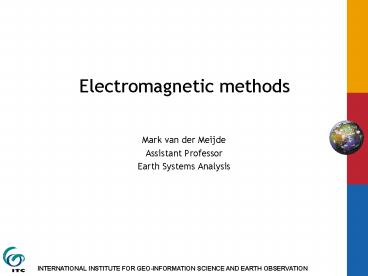Electromagnetic methods - PowerPoint PPT Presentation
1 / 44
Title:
Electromagnetic methods
Description:
INTERNATIONAL INSTITUTE FOR GEO-INFORMATION SCIENCE AND EARTH ... Ampere's Law. H = magnetic field intensity (A/m) J = current density (A/m2) ... Ampere's Law ... – PowerPoint PPT presentation
Number of Views:1729
Avg rating:3.0/5.0
Title: Electromagnetic methods
1
Electromagnetic methods
- Mark van der Meijde
- Assistant Professor
- Earth Systems Analysis
2
Contents
- Objectives
- Introduction
- Theory EM
- Applications
- Field experiment
- Assignment / Self-study
- Presentations (groups)
- Assignment Serrata
3
Introduction
- If ground is very resistive we use inductive
methods to create currents in the ground - Frozen ground
- Very resistive (or insulating) surface, e.g. sand
4
Resistivity of Earth material
5
Theory EM
- A time-varying electromagnetic field on the
surface will create currents in the ground - These currents will create potential differences
in conductive bodies - These potential will create new electromagnetic
fields
6
Theory - equations
- Electromagnetic theory is based on Maxwell
equations (1864) - Maxwell equations are mathematical expressions of
two important laws - Faradays Law (1832)
- Amperes Law (?)
7
Amperes Law
- Amperes Law states that
- A magnetic field is produced by an electric
current - The magnetic field is proportional to the
electric current
8
Amperes Law
- H magnetic field intensity (A/m)
- J current density (A/m2)
- D electric displacement (C/m2)
9
Amperes Law
- A magnetic field is generated in space by current
flow and the field is proportional to the total
current
10
Faradays Law
- Faradays Law states that
- An electric voltage is produced wherever there is
a time varying magnetic field. - The voltage is proportianal to the time rate of
change of the magnetic field
11
Faradays Law
- E electric field intensity (V/m)
- B magnetic flux density (Teslas (T))
12
Faradays Law
- An electric field exists in the region of a
time-varying magnetic field
13
EM methods
- EM methods are based on these two laws
- For illustration of the technique we will look at
a horizontal two loop EM system - One loop is the transmitter, the other is the
receiver
14
EM theory creation of mag field
15
EM theory - induction
surface
16
EM theory secondary field
-
17
Theory - EM fields
- General phase diagram
18
Theory - EM fields
- Sinusoidally varying field A
- Can be represented in plane diagram by
- rotating vector P
19
Theory - EM fields
- A secondary field B results in second vector S
- Difference in phase between vectors
Resulting vector R combination PS
P
20
Theory - EM fields
Primary field A in time can be represented
by Second field B has phase difference with
respect to P
21
Theory - EM fields
Resulting field in time can be represented by
22
Theory - EM fields
- Similar for the
- resultant-field phase
- Secondary field amplitude
- Secondary field phase
23
Theory - EM fields
- It is important to realize what we measure.
- We measure resultant field R and its phase.
- Amplitude P of primary field A can be calculated
from source-receiver geometry - If P and R are known, we can calculate S and its
phase
24
Theory - EM fields
The field R can be split up in a
real and an imaginary component
25
Theory - EM fields
- Different names for same parameters
- real component
- in-phase component
- imaginary component
- out-of-phase component
- quadrature component
26
Theory - EM fields
- A very common representation for electromagnetic
fields it to treat the axis as parts of a complex
plane
imagnary
Real
27
Single frequency EM EM31
28
Single frequency EM EM31
29
Single frequency EM EM31
30
Single frequency EM - minerals
31
Single frequency EM - environment
- Relation pollution - conductivity
32
Multi-frequency EM34 - transmitter
33
Receiver
34
Connected by cable
35
EM34
36
EM34
37
Depth of investigation
- Investigation depth is a function of
- Coil separation
- Resistivity of medium of propagation
- Depth of investigation (skin depth) is defined
as the depth of which 1/3 of energy is
attenuated
38
Depth of investigation
- Skindepth
- This is valid for frequency below 100 kHz
- at higher frequencies displacement curves are
generated - And permittivity becomes important (GPR)
operating frequency
conductivity
39
Depth of investigation
- Depth of exploration for EM
- Also called skin-depth
40
Field exercise EM31
- See behaviour of EM signals on burried objects
and objects on surface (like cars) - Detect buried objects in ITC backyard
- Analyze signal
- Bring paper, pen
41
Assignment
- 2 groups
- Study of specific topic
- Max 5-10 min presentation tomorrow
- Different material supplied, check library,
internet, articles, lecture books
42
Assignment 1
- Study the different behaviour of EM signals over
specific targets - Make an overview of characteristic behaviour
(location of troughs, shoulders depending on
anomaly) - Present to other students
43
Assignment 2
- Investigate the different EM methods/techniques
(e.g. EM31, EM34, VLF, GPR, etc) - Summarize characteristics for each method
(frequency, depth of exploration, most used
for..) - Present to other students
44
Literature
- Parasnis
- Principles of applied geophysics
- Telford, Geldart, Sheriff
- Applied geophysics
- Ch 6, Unesco manual
- TN6 by Geonics































